| Technology and Newspapers | ||
| Production | Distribution | Consumption |
| Reporter/Journalist Pen/Pencil/paper/word processor/ printer/telephone editors photographers printers audio recorder camera editing software | large scale printing press lorries/vans/cars stacks/shelves/display cases subscription app/website marketing – adverts data/ shares # persuasion/manipulation/ governments support invested interest | Paper Phone/Tablet/computer/laptop – digital device ability to read |
Monthly Archives: January 2020
Filters
New Technology and the News
| Technology and Newspapers | ||
| Production | Distribution | Consumption |
| printing press, advertisements, stories, articles, opinions, telephone, audio recorder, camera, editing software, money, government, | printing press, lorries, vans,cars,aeroplanes,drones,shelfs | paper, reading ability, |
| Cover of the first edition | |
| Authors | Edward S. HermanNoam Chomsky |
|---|---|
| Country | United States |
| Language | English |
| Subject | Media of the United States |
| Publisher | Pantheon Books |
| Publication date | 1988 |
| Media type | Print (Hardcover, Paperback) |
| ISBN | 0-375-71449-9 |
| OCLC | 47971712 |
| Dewey Decimal | 381/.4530223 21 |
| LC Class | P96.E25 H47 2002 |
| Preceded by | The Fateful Triangle: The United States, Israel, and the Palestinians |
| Followed by | Necessary Illusions |
Manufacturing Consent: The Political Economy of the Mass Media is a 1988 book by Edward S. Herman and Noam Chomsky, in which the authors propose that the mass communication media of the U.S. “are effective and powerful ideological institutions that carry out a system-supportive to promote a political cause or point of view., by reliance on market forces, internalised assumptions, and self-censorship, and without overt coercion”, by means of the propaganda model of communication. The title derives from the phrase “the manufacture of consent,” employed in the book Public Opinion (1922), by Walter Lippmann (1889–1974).The consent referred to is consent of the governed.
The book was revised 20 years after its first publication to take account of developments such as the fall of the Soviet Union. There has been debate about how the Internet has changed the public’s access to information since 1988.
useful video to explain more clearly what’s written above
manufactoring concent
So how does this process of ‘manipulation’ or ‘persuasion’ work?
- Structures of ownership-companies advertise their products for you to buy. The government may advertise for you to do something e.g. propaganda (sign up for war).
- The role of advertising-Media costs more than consumers will pay: Advertisers fill the gap. Advertisers buy the audience off the media to sell more products. The media as a whole isn’t just selling products to you but they are also selling to advertises with you as the product.
- Links with ‘The Establishment’
- Diversionary tactics – ‘flack’
- Uniting against a ‘common enemy’–
agenda setting- Agenda-setting is the creation of public awareness and concern of the big issues by the news media. The media attempts to influence viewers, and establish a hierarchy of news importance.
- Two basic ideas underpin agenda-setting:
- the press and the media do not reflect reality; they filter and shape it
- media concentrates on a few issues and subjects leads the public to perceive those issues as more important than other issues.
- examples are: Brexit
Immigration
Terrorism
Paedophiles
The internet/hackers/grooming
- framing–
- media myth making-
- conditions of consumption-
Task 1: New Technology and the News. CSP 8
| Technology and Newspapers | ||
| Production | Distribution | Consumption |
| Printers Editing Software Computers/Devices Printer Word software Large-scale printing press Backup area – store the papers/ stories Stationary – pen,pencil,paper Audio Recorder Digital Camera Journalist/ photographers | Printing Press Veichles to transport papers Shops to sell papers | Paper – the physical thing The ability to read ans understand the content Digital devices |
To “manufacture consent” is to create a system in which citizens become willing and obedient, consenting and unquestioning. views private media is businesses interested in the sale of a product—readers and audiences—to other businesses (advertisers) rather than that of quality news to the public. The audience doesn’t question the papers sources or ideas, simply consuming everything presented to them.
Quotes – Noam Chomsky theory based
‘Normally, news coincides with and reinforces the definition of the political situation evolved by the political elite’.
‘The result was that the media amplified elite disagreements in unsettling and unpredicatable ways’.
‘Major media conglomerates control more and more of the worlds media. Where media isn’t controlled by coporations, it is controlled by the state’.
‘The media ‘serve to moblilize support for the special interest that dominate the state and private industry’.
New media and the news
| Technology and Newspapers | ||
| Production | Distribution | Consumption |
| Journalist editors photographers producers writers printers editing software | delivery drivers subscriptions lorries, vans, cars, boats website app | Phones tablets paper shops stands computer |
Noam Chomsky on manufacturing consent
Manufacturing Consent: The Political Economy of the Mass Media is a 1988 book by Edward S. Herman and Noam Chomsky, in which the authors propose that the mass communication media of the U.S. “are effective and powerful ideological institutions that carry out a system-supportive propaganda function, by reliance on market forces, internalised assumptions, and self-censorship, and without overt coercion”.
Propaganda is information that is used primarily to influence an audience. This process of ‘manipulation’ or ‘persuasion’ works in five ways:
- Structures of ownership: Large companies working together to deliver propaganda
- The role of advertising: Influential language and media to gain and manipulate an audience into buying a product that would potentially ‘better their lives’.
- Links with ‘The Establishment’
- Diversionary tactics – ‘flack’
- Uniting against a ‘common enemy’
new technology and the news
| Technology and Newspapers | |||
| Production | Distribution | Consumption | |
| computer | large scale printing press | phones tv computers tablets headphones websites | |
| camera | lorries vans cars | ||
| pen pencil paper | stacks shelves | ||
| word processor | |||
| printer | |||
| telephone | |||
| audio recorder | |||
Noam Chomsky Manufacturing consent:
Herman and Noam Chomsky, in which the authors propose that the mass communication media of the U.S. “are effective and powerful ideological institutions that carry out a system-supportive propaganda function, by reliance on market forces, internalized assumptions, and self-censorship, and without overt coercion
3 quotes
the link between ownership of news organisations and news coverage is not easy to determine.
advertising in news papers attracts small concentrated elite audience.
major media conglomerates control more and more of the worlds media.
CSP 8 – THe I
| Technology and Newspapers | ||
| Production | Distribution | Consumption |
| – Reported by journalists – Sent in by consumers – Laptop/computer – Word processing software – telephone – pen and paper – printers – send out journalists to create the article/report – audio recorder – camera/ digital camera – photographers – email software to gather information – editing software | – paper format as a newspaper – free newspapers that are available in airports – distributed by lorries, vans and cars – air cargo distribution – distributed into shops, bookshops and newsagents – large scale printing press – stacks – shelves – display cases – paper rounds by the “paper boy/girl” | – available in paper form – available in digital form -bought from shops – available to read digital copies on electronic devices and mobile devices. – daily subscriptions – premium subscriptions (with perks such as free digital copy included) |
Noam Chomsky – Manufacturing Consent

This is a book that is written by Chomsky and Edward S Herman, which proposes that the mass communication medias of the US are “effective and powerful ideological institutions that carry out a system-supportive propaganda function, by reliance on market forces, internalized assumptions, and self-censorship, and without overt coercion”.
5 Filters of Mass Media
- Structure of ownership – Conglomerates use vertical integration to use their subsidiary to produce newspapers.
- The role of advertising – many newspapers use advertising i n order to pay off the production costs of producing their newspaper. For example, they may charge a company money to advertise on the back page on their newspaper.
- Links with ‘The Establishment’ – Media can link with the government and politics. Such as Sinclair (5 Filters of Mass Media machine and Donald Trump are really good friends, meaning Trump could decide to back his friend up.
- Diversionary Tactics (‘Flack’) – Another word for flack is noise/distraction. This is when they make a story that could be seen as ‘fake news’ and distracts people from important news to cover up the newspaper company. For example, there might be the bush fires in Australia, but newspapers seem more interested in celebrities at the BAFTAs.
- Uniting against a ‘common enemy‘ – these include communists, terrorists and anti-supporters. The newspaper might produce an article to give a bad reputation to something (ie North Korea and Kim Jong Un)
Agenda setting – the creation of public issues, but can be filtered what articles are covered in order to emphasise and spread propaganda about a certain topic and issues that might interest their target reader.
Framing – how something is presented to the audience. Factors that influence framing include Gender, Race, Politics, Age, Society/Cultural trends and the economic issues and the influence of sponsors and money.
Myth making – when you create a statement or belief that hasn’t been backed up by anything, therefore people are hesitant to believe, meaning some people believe it but some people don’t.
The Sociology of News Production
- Major media conglomerates control more and more of the world’s media
- The “velvet revolution” in Eastern Europe (1989) raises related doubts about the attributions of unlimited power to the socialist state
- The link between ownership of news organisations and news coverage is not easy to determine. It’s hard to tie patterns of ownership to specific habits of reporting.
- The political economy perspective in Anglo-American media studies has generally been insensitive to political and legal determinants of news production, it has been far more “economic” than political”
Quotes new technology
“capable of predicting personality” – teen vogue can predict what people want to see “businesses can change behaviour to match each user’s personality“
“user personality can be easily and effectively predicted from public data”
“what it does is change people’d behaviour by using carefully crafted messages”
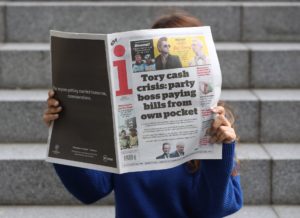
CSP 8: The i
In the exam, newspapers will feature in Section 3. Section 3 expects students to produce long answer questions about all four key theoretical areas of this course:
- Media Language
- Media Representation
- Media Audiences
- Media Institutions
If you haven’t seen this video (which was posted for CSP 7 TeenVogue, then watch it now, as there is a clear link between news, new media technologies, societies, politics, economics and individual lives.
Task 1: New Technology and the News
Technology is central to any Media Studies course, and is of relevance in terms of news, newsgathering, production, distribution and consumption, as well as playing a significant role in terms of democracy, knowledge, access and truth. As a starter exercise to understand this relationship in terms of news production, create a table and see how many different technologies you can put in each box, to show which what technologies are used in each stage of the production process.
| Technology and Newspapers | ||
| Production | Distribution | Consumption |
| pen / pencil / paper word processor / printer telephone camera microphone license computer trees DTP data processors sources of information | (large scale) printing press lorries / vans / cars stacks / shelves / display cases / boxes social media platforms company / organisation / individual to deliver product storage billboards paper boys/girls target audience | paper (the ability to read? & understand?) a digital device (ipad/phone, computer reading glasses / eyes / braille / audio provision (headphones) WiFi target audience |
Media Institutions
So the link between new media technologies, corporate ownership and the media is . . . ‘Manufacturing Consent?’
Some such as theorist, academic and intellectual Noam Chomsky, that the media is a mechanism that is deliberately used by the rich and the powerful (the elite) as a way of ‘Manufacturing Consent’
If you want to a good documentary film that explores the way “uniformed electorate make irrational decisions” Chomsky, watch the film Get Me Roger Stone . . .
Task 2: reading and thinking
“The link between media ownership of news organisations and news coverage is not easy to determine” which is briefly discussed and summarised in The Sociology of News Production by Michael Schudson.
Read this hand out and extract 3-4 short pithy quotes (that you could use in your exam answer) that helps to show your understanding and knowledge ie make sense to you. For example . . . .
- the suggestion that the news media ‘reinforces’ a political situation (Murdock, 1982), or the idea that
- ‘different stances different news organisations or types of organisations take toward different audiences in the marketplace‘ (Curran et al, 1980), or
- the proposition that “major media conglomerates control more and more of the world’s media. Where media are not controlled by organisations, they are generally voices of the state.”
- the propaganda model that the media ‘serve to mobilize support for the special interests that dominate the state and private activity‘ (Chomsky, 1988)
So how does this process of ‘manipulation’ or ‘persuasion’ work?
- Structures of ownership
- The role of advertising
- Links with ‘The Establishment’
- Diversionary tactics – ‘flack’
- Uniting against a ‘common enemy’
In another approach, we can suggest that the media are ‘agenda setting’, look at this powerpoint to understand what this could mean in terms of The i: AGENDA SETTING
AGENDA SETTING
FRAMING
MYTH MAKING
CONDITIONS OF CONSUMPTION
In summary, we need to be able to read the signs . . .
In other words, the media are biased!
In terms of setting an agenda and mapping a clear political bias watch the video below where anchors at Sinclair-owned local news stations parrot a script pushing Trump talking points and “the troubling trend of irresponsible, one sided news stories plaguing our country.”
So can we trust the media?
How can the Media act in the ‘Public Sphere’ in the ‘Public Interest’?
“a public space between the private domain and the state in which public opionion was formed and ‘popular’ supervision of government was established” (p. 82: 1996)
Task 3: Note taking
Look at the following extracts and note 5-10 bullet points that shows your understanding of ‘the public sphere‘ and the media as watchdog. Focus on what these terms mean and how did they emerge and develop. For example, in the extract: Mass Media and Democracy by James Curran there is a focus on Jurgen Habermas and his concept of the ‘Public Sphere‘, basically arguing that the developments in education and the mass media allowed for a greater access to information particularly with regard to government, authority and the exercise of control. Similarly, Denis McQuail aruges for a media that specifically works in the public interest and not in a purely commercial interest.

- Mass Media in the Public Interest (Denis McQuail)
- Mass Media and Democracy (James Curran) in the Public Service.
- For further reading and more in depth reflection look at this chapter from Brian McNair’s book Introduction to Political Communication (2011)
This links to the main proposition that we faced earlier in the academic year which was: in what ways are the culture industries different from other industries? Which was put forward in this extract from this opening chapter Culture Communication & Political Economy by Golding and Murdock from Mass Media and Society by James Curran and Michael Gurevitch,
A good starting point is to read this summary of James Curran and Jean Seaton’s work found on page 121 of the AQA Media Studies text book (Hendry & Stevenson), that highlights their 1997 book: Power without Responsibility (James Curran and Jean Seaton) .
“shows how different ways of financing and organising cultural production have traceable consequences for the range of discourses and representations in the public domain” (p.11: 1996)
but . . . we need to be careful of astroturfing …
And our own ‘Political Bias’
Task 4: Complete the Political Compass Survey to give you an understanding of left / right . . . authoritarian / libertarian . . .
If news media (and other media forms?) exhibit bias, how can we identify and critically understand it? A good starting point may be to identify our own social-economic-political bias, so take this survey from ‘The Political Compass’ (link to test).
Post up the image of your results from the Political Compass and make some brief notes that show your understanding of left / right politics and authoritarian / libertarian forms of social control.
About the Political Compass
In the introduction, we explained the inadequacies of the traditional left-right line.

If we recognise that this is essentially an economic line it’s fine, as far as it goes. We can show, for example, Stalin, Mao Zedong and Pol Pot, with their commitment to a totally controlled economy, on the hard left. Socialists like Mahatma Gandhi and Robert Mugabe would occupy a less extreme leftist position. Margaret Thatcher would be well over to the right, but further right still would be someone like that ultimate free marketeer, General Pinochet.
That deals with economics, but the social dimension is also important in politics. That’s the one that the mere left-right scale doesn’t adequately address. So we’ve added one, ranging in positions from extreme authoritarian to extreme libertarian.
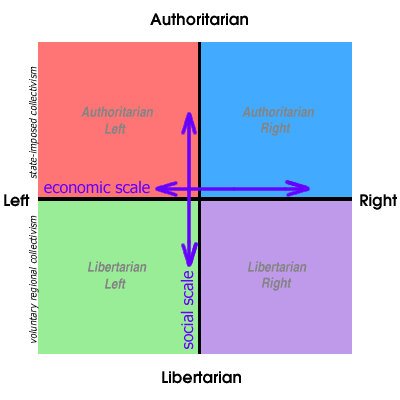
Both an economic dimension and a social dimension are important factors for a proper political analysis. By adding the social dimension you can show that Stalin was an authoritarian leftist (ie the state is more important than the individual) and that Gandhi, believing in the supreme value of each individual, is a liberal leftist. While the former involves state-imposed arbitrary collectivism in the extreme top left, on the extreme bottom left is voluntary collectivism at regional level, with no state involved. Hundreds of such anarchist communities existed in Spain during the civil war period
You can also put Pinochet, who was prepared to sanction mass killing for the sake of the free market, on the far right as well as in a hardcore authoritarian position. On the non-socialist side you can distinguish someone like Milton Friedman, who is anti-state for fiscal rather than social reasons, from Hitler, who wanted to make the state stronger, even if he wiped out half of humanity in the process.
The chart also makes clear that, despite popular perceptions, the opposite of fascism is not communism but anarchism (ie liberal socialism), and that the opposite of communism ( ie an entirely state-planned economy) is neo-liberalism (ie extreme deregulated economy)
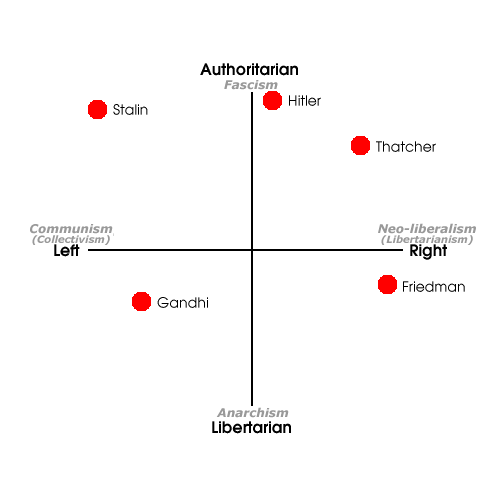
The usual understanding of anarchism as a left wing ideology does not take into account the neo-liberal “anarchism” championed by the likes of Ayn Rand, Milton Friedman and America’s Libertarian Party, which couples social Darwinian right-wing economics with liberal positions on most social issues. Often their libertarian impulses stop short of opposition to strong law and order positions, and are more economic in substance (ie no taxes) so they are not as extremely libertarian as they are extremely right wing. On the other hand, the classical libertarian collectivism of anarcho-syndicalism ( libertarian socialism) belongs in the bottom left hand corner.
In our home page we demolished the myth that authoritarianism is necessarily “right wing”, with the examples of Robert Mugabe, Pol Pot and Stalin. Similarly Hitler, on an economic scale, was not an extreme right-winger. His economic policies were broadly Keynesian, and to the left of some of today’s Labour parties. If you could get Hitler and Stalin to sit down together and avoid economics, the two diehard authoritarians would find plenty of common ground.
A Word about Neo-cons and Neo-libs
U.S. neo-conservatives, with their commitment to high military spending and the global assertion of national values, tend to be more authoritarian than hard right. By contrast, neo-liberals, opposed to such moral leadership and, more especially, the ensuing demands on the tax payer, belong to a further right but less authoritarian region. Paradoxically, the “free market”, in neo-con parlance, also allows for the large-scale subsidy of the military-industrial complex, a considerable degree of corporate welfare, and protectionism when deemed in the national interest. These are viewed by neo-libs as impediments to the unfettered market forces that they champion.

Task 5: Apply the theory to the CSP
Now you have a better understanding of left / right; authoritarian/libertarian forms of government and control, let’s apply the CSP / The i.
Use some of the questions from the survey that you have just taken from The Political Compass and link them to specific examples to the CSP (below).
Set out your approach ie your questions and the examples in a table.
Once you have produced enough data, see if you can plot the compass position of The i (based only on the 3 pages of our CSP.
As an alternative or more refined approach, take the whole test from the perspective of The i.
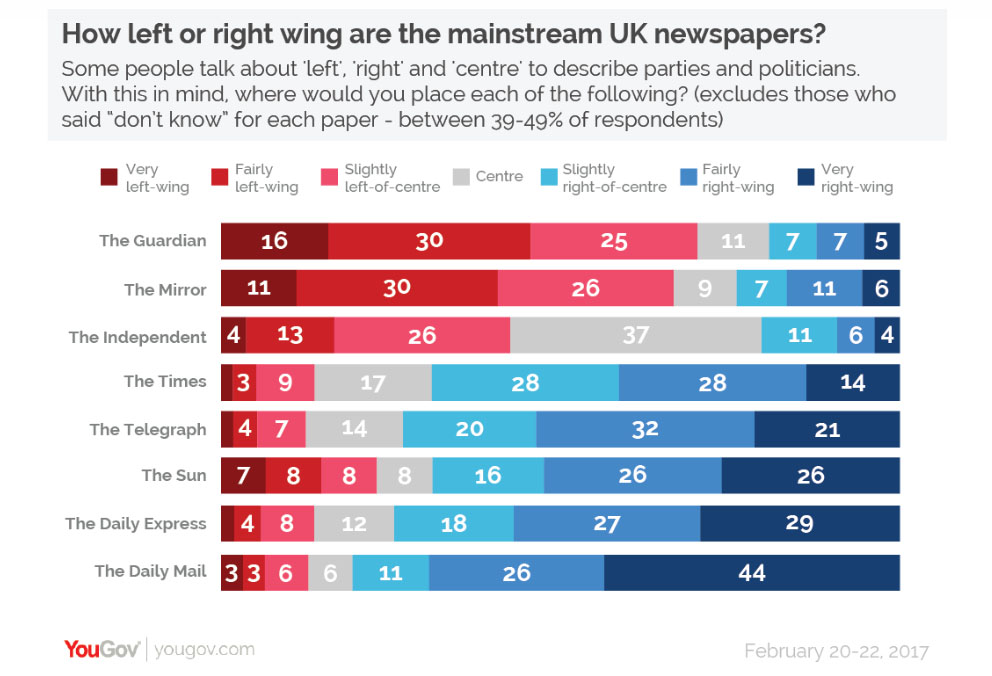

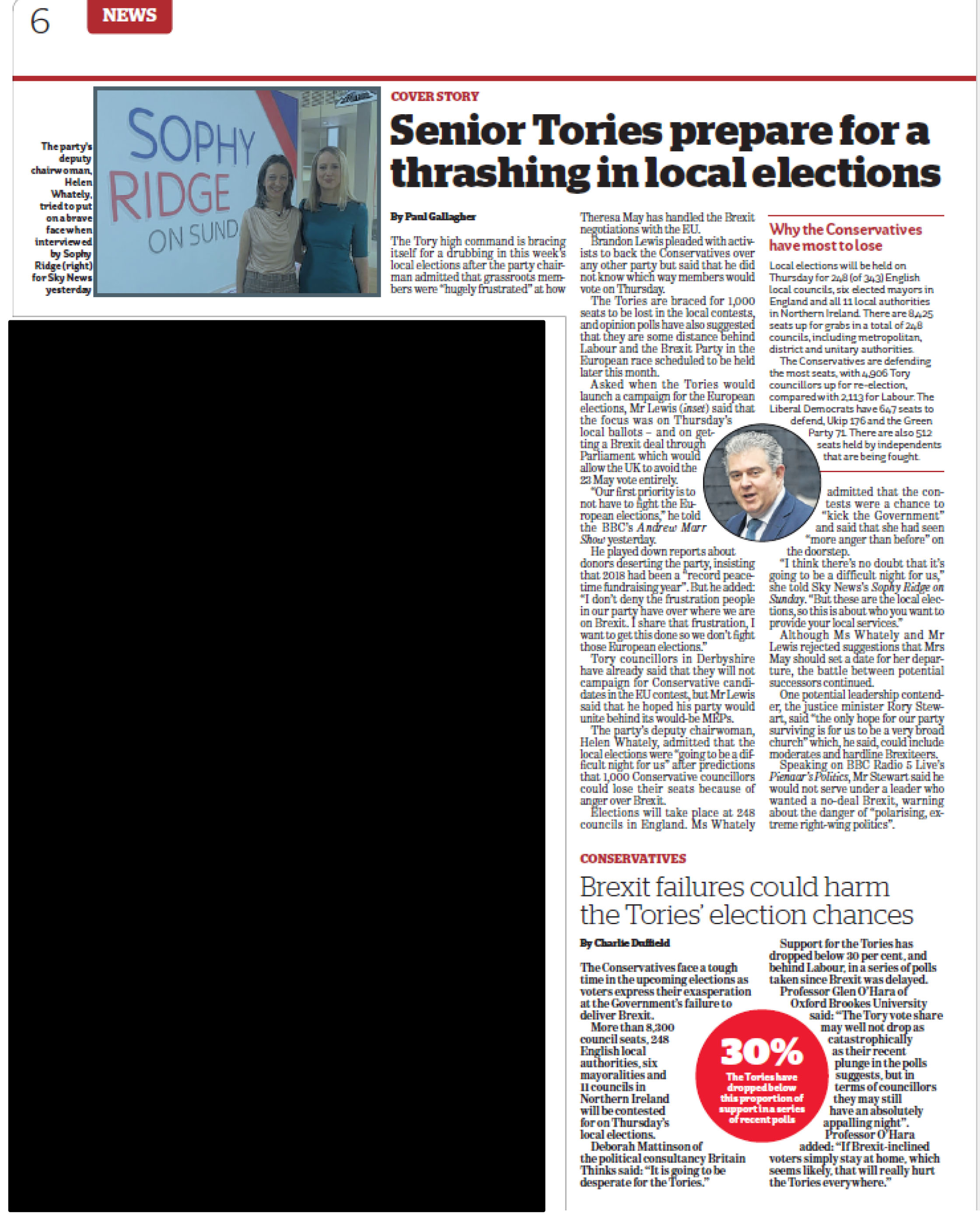
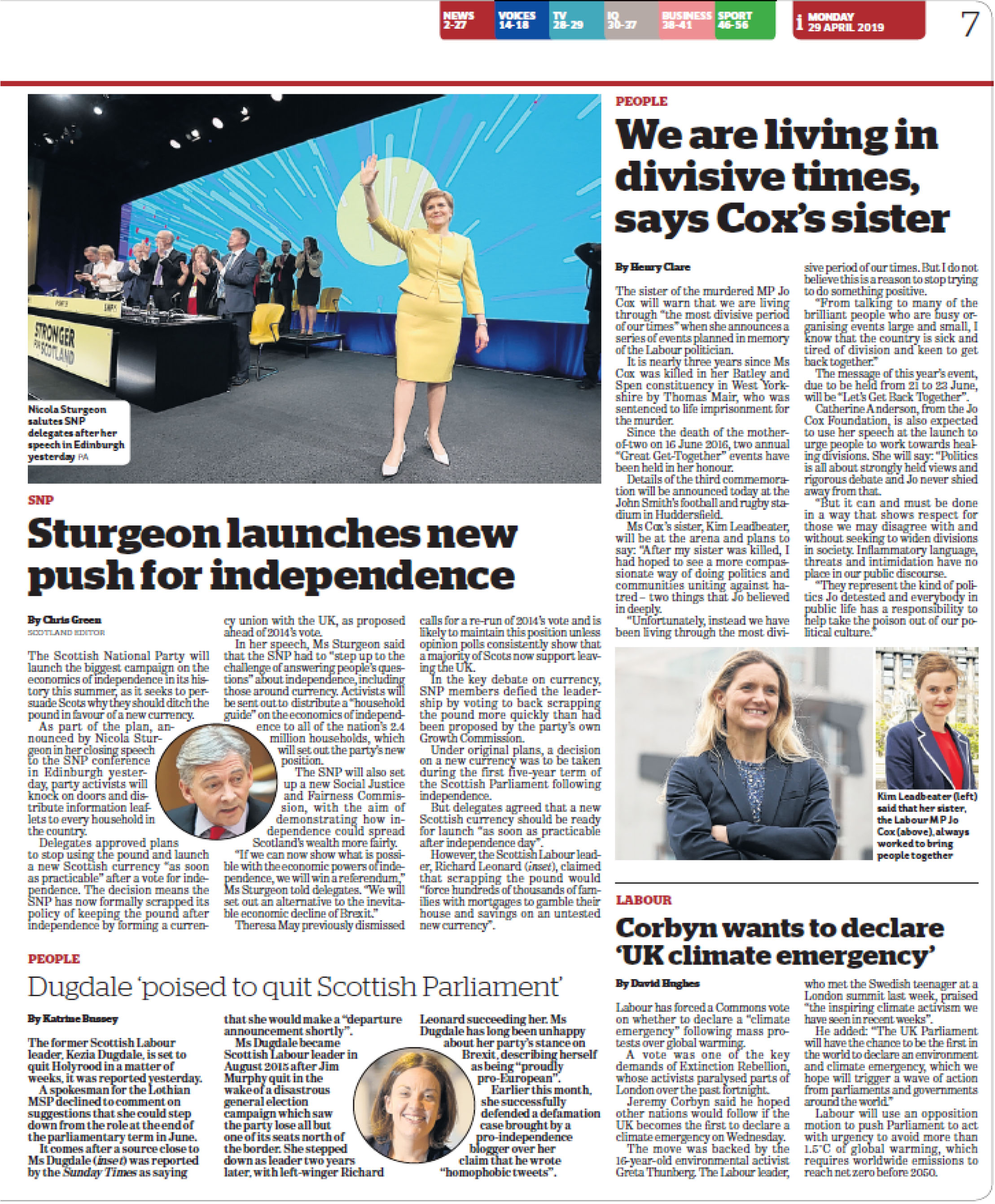
Summing up this CSP
Overall, in this section students are aiming to develop enough knowledge to show understanding of most of the following:
- patterns of ownership and control, including conglomerate mergers, vertical / horizontal integration and diversification
- the impact of economic factors, including commercial and not-for-profit aims and intentions
- the processes of production, distribution and circulation
- the role played by key organisations, groups and individuals in a global context
- how media organisations maintain, varieties of audiences nationally and globally
- recent technological change in terms of production, distribution and circulation
- patterns of consumption and response in terms of new media technologies
- the impact of ‘new’ digital technologies on media regulation, including the role of individual producers
- the regulatory framework of contemporary media in the UK
Task 6: Define these key terms
Now that we have developed an overall understanding, it is time to define and make notes on some key terms that you will need to know for your exam.
- News Values
- Gatekeepers
- Regulation / Deregulation
- Free market vs Monopolies & Mergers
- Media concentration / Conglomerates / Globalisation (in terms of media ownership)
- Vertical Integration & Horizontal Integration
- Neo-liberalism and the Alt-Right
- Surveillance / Privacy / Security / GDPR
- The Leveson Enquiry
- The Cairncross Review (read these questions under consideration: Caincross_call_for_evidence_govuk)
As a final point for this CSP make sure you facts and figures are in place . . .
Task 7: Find 10 Facts about The i
Build up evidence (ie KNOWLEDGE), for example, find some information about:
- History,
- Format,
- Editors,
- Political stance,
- Target Audience,
- Cost,
- Circulation,
- Profit
- etc
Note that the previous owners of The i – Johnston Press were up for sale and were bought out by JPI Media, read this article and that this ownership has recently changed through the acquisition and merger by the Daily Mail group https://www.bbc.co.uk/news/business-50598506 and https://www.theguardian.com/media/2019/nov/29/daily-mail-owner-buys-the-i-newspaper
Or for a brief look at contemporary ownership and control read this BBC article that asks why Billionaires want to own the news?
Assessment
ASSESSMENT: Go to the Planner page/tab and choose either the 7571 Question Paper from 23rd May 2018 and answer question 8. Plan your answer, share your responses and collaborate with others to produce a complete and full answer. Look at the feedback assessment sheet below for starting points and areas that you could / should cover in your answer.
You will also need to specifically refer to Curran and Seaton, so please look at the references to Curran and Seaton in the feedback sheet (and presented below) and look to match these ideas with your own reading of the two texts provided below. The aim is to build up your own knowledge and understanding of Curran and Seaton as this should be central to your answer.
- ‘the United Kingdom regards press freedom as an absolute freedom.’ The government leaves it to the market forces to decide which press products survive’ (1992: 53).
- In the case of the press, with certain limited exceptions, no legal restriction is placed on the right to buy or launch a newspaper. (This ensures, in liberal theory, that the press is free, diverse and representative (Curran and Seaton 2003: 346-7).
- In this view of freedom of expression, it is the interests of the press, not of its readers nor of the subjects of its coverage, which are fundamental. (‘Free enterprise is a pre-requisite of a free press’)
- Based on the assumption that democracy is best served by the free exchange of ideas, for which freedom of expression is vital. (‘the best test of truth is the power of the thought to get itself accepted in the competition of the market’)
quotes – zuboff (mass media)
- “The presentation of Facebook ads could be adjusted based on the personality of the user.”
- “Users no longer have an expectation of privacy.”
- “The researched cautioned that “one can imagine situations in which such predictions, even if incorrect, could pose a threat to an individual’s well being, freedom or even life.”
- “… boasted of its application of personality based “micro-behavioral targeting.” – Zuboff
Quotes
“social media users are dangerously unaware of the vulnerabilities”
“behavioral micro-targeting”
“ad servers can be tailored to reflect the users personality traits”
“predict the precise ways in which each customer will react to marketing efforts”






